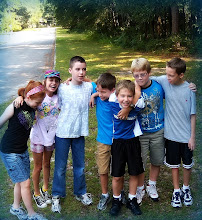October is such a beautiful night sky month, and lately we have had lovely weather for being out and looking up in the dark. It has been dry (at least it was up until this week), so no clouds obscure, and our nighttime temperatures have been warm enough that we don't shiver, yet cool enough to refresh. The full Hunter's Moon from last week was as pretty and clear as I have ever seen it.
{A little parenthetical historical note: When I was growing up, though I lived in the country with no light pollution - I tell ya' it was DARK at night, and still is - I never could see the "man in the moon" or make any sense out of star charts with constellations. I think my vision was already that bad. The moon was just a white disc; and I think I only saw the brightest stars and planets. Now I look up with my glasses or contacts, and I am amazed at the texture I can see.}Shameless copycat that I am, I borrowed from two new art teacher blogs for the lesson: We Heart Art's Spooky Silouettes! lesson and Fine Lines' Ghost Eye Tree lesson. Thank you for sharing, ladies!
{Second parenthetical thought: Perhaps I should have named this blog Copycat Homeshool Art Lessons. KEISUZI, a teacher before she was a homeschool teacher, tells me all teachers are copycats, so I am in good company}I began our lesson with a bit of classical astronomy. We talked about the fall equinox, the harvest moon, and the hunter's moon. Full hunter's moon had just gone by, so the timing was good. After reviewing tints and shades and remembering what monochromatic means, we painted our full moons with tempura on watercolor paper, and cut out dark trees from black construction paper, gluing them on so that the moon shown through the limbs.
Oooooo.....
Then it was on to Spooky Eyes, one of the cutest little projects we have ever done. When I showed my samples to Science Geek, I said "...if we have time, we'll do spooky eyes..." to which she replied, "Oh please get to Spooky Eyes."
Orange cardstock, black Sharpies, and the white punchouts from a hole puncher - easy fun!
When I read about this project originally, I misinterpreted that I was to punch holes in the orange paper and mount white paper behind to shine through. On second, or maybe third read, I realized we were just to glue on the little dots. Ha! Did I feel silly!
I cut 8.5" x 11" orange cardstock into 6" x 11". This resulted in lots of 2.5" x 11" strips. I made one into a scaredy cat bookmark, and sent the others home with the Sm'Arties for homework fun.




























